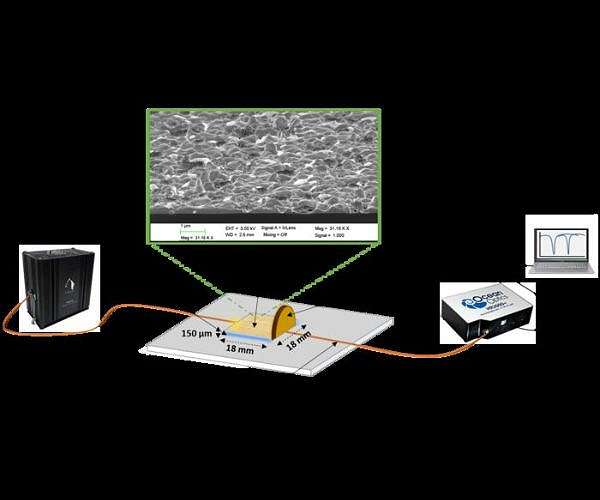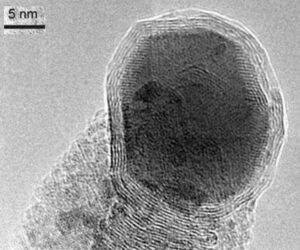
by Hugo Ritmico
Navarra, Spain (SPX) Jan 10, 2024
A recent publication in Opto-Electronic Advances has brought to light a novel use of perovskite nanofilms in generating Lossy mode resonances (LMR), a development with significant implications for the field of optical sensing.
The study delves into the unique qualities of perovskite, a material already renowned for its outstanding optical and electrical properties. Previously utilized in LEDs and solar cells, perovskite's latest application in creating LMR devices marks a different and creative use of this versatile material.
LMR devices operate as ultra-sensitive detectors, capable of detecting minor environmental changes. The effectiveness of these devices hinges on the proper selection of materials for thin films, with perovskite emerging as an ideal choice due to its unique ability to generate LMRs. These LMRs occur at specific 'sweet spots' where light and material interact uniquely, and these points can be adjusted by varying the thickness of the perovskite film.
The researchers likened the mechanism to light passing through a toast coated with perovskite, layered on glass or silicon. The perovskite layer, upon interacting with light, generates LMRs, the characteristics of which can be altered by modifying the perovskite layer's thickness. This results in different LMRs at various light wavelengths.
These devices are versatile in their sensing capabilities, capable of detecting humidity, chemical presence, temperature shifts, and even pressure changes. The practical applications are vast, ranging from air quality monitoring in smartphones to industrial leak detection and environmental safeguarding.
What sets this research apart is the successful experimental demonstration of these perovskite-based LMR devices. The devices created in the study not only exemplified the theoretical potential of perovskite in LMR generation but also showed promising results that matched the theoretical predictions. This achievement underscores the significance of the research in advancing optical sensing technology.
The authors of the article highlight the first-ever experimental proposal of LMR devices using perovskite coatings. This marks a notable advancement in optical sensing, a field with wide-ranging impacts from environmental monitoring to industrial processes and personal health.
Perovskite's adaptability is further evidenced in the creation of LMR devices. These devices essentially act as highly sensitive refractometers, with the interaction of light and the perovskite layer generating optical resonances (LMRs). The ability to tailor these resonances by adjusting the perovskite layer's thickness paves the way for designing various sensors and other optical devices like filters and modulators.
The study's experimental results, which align with theoretical predictions, confirm the practicality of perovskite-based LMR devices. The generation of multiple LMRs at varying thicknesses and the capability to work with both TM and TE polarities represent a substantial leap in the realm of optical sensing. The innovative use of perovskite in creating LMR devices represents a fresh perspective in the field, showcasing the material's remarkable versatility and potential impact across various technological domains.
Research Report:Generation of Lossy mode resonances (LMR) using perovskite nanofilms
Related Links
Public University of Navarra
All About Solar Energy at SolarDaily.com
- SEO Powered Content & PR Distribution. Get Amplified Today.
- PlatoData.Network Vertical Generative Ai. Empower Yourself. Access Here.
- PlatoAiStream. Web3 Intelligence. Knowledge Amplified. Access Here.
- PlatoESG. Carbon, CleanTech, Energy, Environment, Solar, Waste Management. Access Here.
- PlatoHealth. Biotech and Clinical Trials Intelligence. Access Here.
- Source: https://www.solardaily.com/reports/Perovskite_nanofilms_open_new_horizons_in_optical_sensing_technology_999.html
- :has
- :is
- :not
- :where
- 10
- 2024
- a
- ability
- About
- achievement
- across
- Act
- Adjusted
- adjusting
- advancement
- advances
- advancing
- AIR
- align
- already
- also
- altered
- an
- and
- apart
- Application
- applications
- ARE
- article
- AS
- At
- authors
- BE
- both
- brought
- but
- by
- CAN
- capabilities
- capability
- capable
- Cells
- Changes
- characteristics
- chemical
- choice
- Confirm
- created
- Creating
- creation
- Creative
- designing
- Detection
- Development
- Devices
- different
- domains
- due
- effectiveness
- emerging
- energy
- environmental
- essentially
- Even
- evidenced
- experimental
- field
- Film
- films
- filters
- first-ever
- For
- fresh
- from
- further
- generate
- generates
- generating
- generation
- glass
- Health
- Highlight
- highly
- hinges
- Horizons
- HTTPS
- hugo
- ideal
- Impact
- Impacts
- implications
- in
- industrial
- innovative
- interact
- interacting
- interaction
- into
- ITS
- Jan
- jpg
- latest
- layer
- layered
- leak
- Leap
- light
- like
- lmr
- matched
- material
- materials
- mechanism
- minor
- Mode
- monitoring
- multiple
- New
- new horizons
- notable
- novel
- occur
- of
- on
- only
- open
- operate
- or
- Other
- outstanding
- Passing
- paves
- personal
- Personal Health
- perspective
- plato
- Plato Data Intelligence
- PlatoData
- points
- potential
- Practical
- Practical Applications
- Predictions
- presence
- pressure
- previously
- processes
- promising
- proper
- properties
- proposal
- Publication
- qualities
- quality
- ranging
- realm
- recent
- remarkable
- Renowned
- report
- represent
- represents
- research
- researchers
- Results
- s
- safeguarding
- selection
- sensitive
- sensors
- Sets
- Shifts
- showcasing
- showed
- significance
- significant
- Silicon
- smartphones
- solar
- Solar cells
- solar energy
- Spain
- specific
- spots
- spx
- Study
- substantial
- successful
- sweet
- technological
- Technology
- that
- The
- their
- theoretical
- These
- this
- Through
- TM
- to
- toast
- underscores
- unique
- uniquely
- university
- upon
- use
- using
- utilized
- various
- varying
- Vast
- versatile
- versatility
- wavelengths
- Way..
- What
- which
- with
- Work
- zephyrnet












